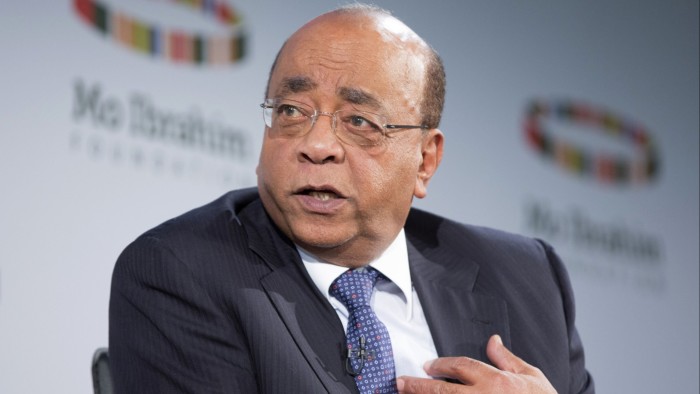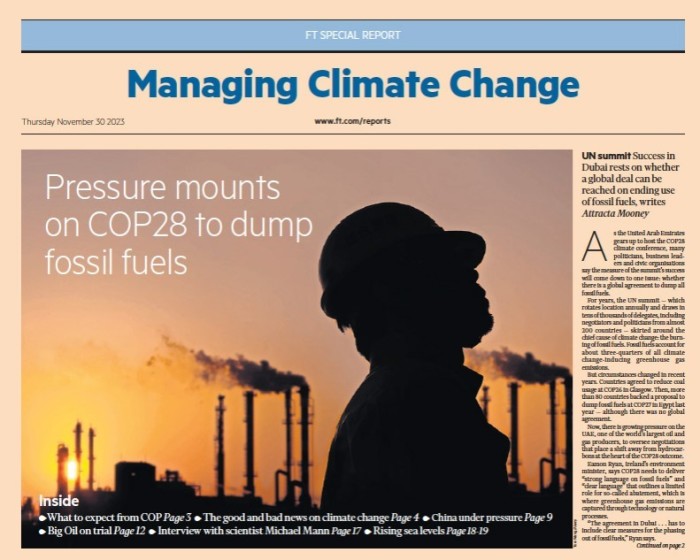African nations unite on Nairobi Declaration

Simply sign up to the Climate change myFT Digest -- delivered directly to your inbox.
For years, many African countries have struggled to position themselves in relation to the climate debate raging in the global north.
The continent of 54 countries, which has emitted less than 3 per cent of cumulative carbon, is the least equipped financially to deal with the consequences — whether droughts (or flash floods) in the Horn of Africa, or changing weather patterns for smallholder farmers who depend on rain to water their crops.
Meanwhile, demands that nations such as Nigeria, Angola or Mozambique — all big or potentially big producers of hydrocarbons — should forgo exploiting their oil and gas resources strike many as absurd when 600mn Africans lack access to regular electricity supplies.
“Every American man, woman and child emits 17 tonnes of carbon; every European emits 6.5-7 tonnes of carbon a year,” Mo Ibrahim, a Sudanese-British billionaire and governance campaigner, told the Africa Climate Summit in Nairobi in September — adding that emitters should pay for their emissions through a tax. “Who gives you the right to emit all this carbon? If you pay for it, then you’ll change.”

This article is part of an FT special report on Managing Climate Change
But, now, the Nairobi Declaration, adopted by the 54 nations of the African Union at the September summit, offers an opportunity to rally around a common position. It recognises climate change as “the single biggest threat to all life on Earth” and demands “urgent and concerted action from all nations to lower emissions”, within the framework of “common but differentiated responsibilities”.
According to Akinwumi Adesina, president of the African Development Bank: “The very fact that African leaders and heads of institutions came together to say that it is time for Africa’s needs, in particular for climate adaptation, to be known . . . that, itself, is a success.”
The declaration calls for developed nations to cut carbon emissions more quickly. It also links the climate issue to what African leaders say is a pressing need to overhaul a global financial system that, they argue, condemns countries to perpetual indebtedness and deprives them of the resources needed to adapt their economies.
“We call for a comprehensive and systematic response to the incipient debt crisis outside default frameworks,” it states. Among the proposals is a tax on fossil fuel trade, maritime transport and aviation, as well as a global financial transaction tax to provide “affordable and accessible finance for climate positive investments at scale”.
The declaration also calls for the implementation of a long-discussed plan to reallocate IMF special drawing rights to poorer nations. Many countries lack the financial resources to protect rainforests, develop climate-resistant infrastructure or food strategies, or to build industries to compete in a low-carbon economy. As African leaders put it in the declaration: “No country should ever have to choose between development aspirations and climate action.”
Adesina says the Nairobi Declaration emphasises the need to step up renewable energy generation on the continent, to insure against climate-related disasters, to recognise Africa’s renewable energy potential and carbon sinks, and to build a strategy for critical minerals.
The AfDB backs each of these requirements, he adds, citing the bank’s support — with a $50mn fund and a $250mn blended finance facility — of a planned 10GW “desert to power” solar development in the Sahel region. By 2025, this project is supposed to bring power to 250mn people in 11 countries, 90mn of them for the first time. The AfDB has also set up a facility to insure countries against catastrophic weather events, Adesina says, and 15 have already taken out policies.
James Mwangi, founder of Climate Action Platform for Africa, a think-thank, highlights the declaration’s commitment to what he calls “green industrialisation”. He points to ArcelorMittal’s “decarbonisation road map” in South Africa as an example. The steel multinational is piloting a project to produce green sheet steel using green hydrogen made in either South Africa or Namibia: “Instead of moving a volatile, hard-to-move gas somewhere else, just do the stuff you’re going to do in place.”
Kenya, which has abundant geothermal resources, presents further opportunities. It could manufacture goods with low embedded carbon — potentially an advantage once the EU’s Carbon Border Adjustment Mechanism comes into effect from 2026.
There is also potential for Africa in carbon removal, through technologies such as biochar — a carbon-like substance made from burning organic material at high temperatures — Mwangi says. However, there are still many sceptics, he concedes.
Even so, for him, the Nairobi Declaration is the flicker of recognition that, in positioning itself in response to climate change, Africa should be much more ambitious.
Climate Capital

Where climate change meets business, markets and politics. Explore the FT’s coverage here.
Are you curious about the FT’s environmental sustainability commitments? Find out more about our science-based targets here

Comments